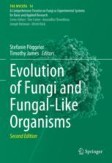Search
Search Results
-
High-Throughput Phenoty** and Its Importance in Host Plant Resistance
Plant phenoty** has been the topic of research for several decades across the globe, which has made significant contributions to the advancements...
-
Broad host tropism of ACE2-using MERS-related coronaviruses and determinants restricting viral recognition
Recently, two Middle East respiratory syndrome coronavirus (MERS-CoV) closely related to bat merbecoviruses, NeoCoV and PDF-2180, were discovered to...

-
Influence of Host Plants and Tending Ants on the Cuticular Hydrocarbon Profile of a Generalist Myrmecophilous Caterpillar
In myrmecophilous organisms, which live in symbiosis with ants, cuticular hydrocarbons (CHCs) play a pivotal role in interspecific communication and...

-
Macrophage-mediated trogocytosis contributes to destroying human schistosomes in a non-susceptible rodent host, Microtus fortis
Schistosoma parasites, causing schistosomiasis, exhibit typical host specificity in host preference. Many mammals, including humans, are susceptible...

-
Behavioral and electrophysiological responses of cabbage aphids to odors from host plants infested by conspecific and heterospecific herbivores
Behavioral and electrophysiological studies on aphid responses to host plant odors, although important, are still not exhaustive for some species....

-
Alterations in gut microbiota and host transcriptome of patients with coronary artery disease
BackgroundCoronary artery disease (CAD) is a widespread heart condition caused by atherosclerosis and influences millions of people worldwide. Early...

-
Predicting the potential for zoonotic transmission and host associations for novel viruses
Host-virus associations have co-evolved under ecological and evolutionary selection pressures that shape cross-species transmission and spillover to...

-
Disturbance and disease: host–parasite interactions in freshwater streams remain stable following wildfire
Increases in the intensity and frequency of wildfires highlight the need to understand how fire disturbance affects ecological interactions. Though...

-
Burning questions for fire blight research. II. Critical next steps in disease management and in host resistance breeding of apple and pear
Fire blight is a devastating disease of apple and pear worldwide. One reason fire blight is so difficult to manage is because of the lack of...

-
Staphylococcus aureus host interactions and adaptation
Invasive Staphylococcus aureus infections are common, causing high mortality, compounded by the propensity of the bacterium to develop drug...

-
Detection of Endophytes by Immunological Methods
Endophytes are hidden companion of plant species and reside within healthy plant tissues without causing any apparent symptoms and noticeable injury...
-
Host Genetic Background Effect on Vertical Seed Transmission of Epichloë Endophyte Strains in Tall Fescue
Tall fescue ( Lolium arundinaceum (Schreb.) Darbysh.) is a cool-season perennial grass widely grown for forage and turf. Tall fescue lives in...

-
Genetic manipulation of giant viruses and their host, Acanthamoeba castellanii
Giant viruses (GVs) provide an unprecedented source of genetic innovation in the viral world and are thus, besides their importance in basic and...

-
The cryptic microbiota of plant parasitic and entomopathogenic nematodes: diversity, effects on host biology and potential in plant protection
Many plant parasitic and entomopathogenic nematodes harbor specialized and obligate bacteria as well as viruses. Given their evolutionary...

-
Visual and chemical cues in the host plant selection of the melon ladybird Chnootriba elaterii (Coleoptera: Coccinellidae)
Phytophagous insects employ various sensory cues in the host plant location such as visual, olfactory, gustatory, and tactile stimuli, which are...

-
Host-derived organic acids enable gut colonization of the honey bee symbiont Snodgrassella alvi
Diverse bacteria can colonize the animal gut using dietary nutrients or by engaging in microbial crossfeeding interactions. Less is known about the...

-
Co-diversification of an intestinal Mycoplasma and its salmonid host
Understanding the evolutionary relationships between a host and its intestinal resident bacteria can transform how we understand adaptive phenotypic...

-
Type III secretion system effector YfiD inhibits the activation of host poly(ADP-ribose) polymerase-1 to promote bacterial infection
Modulation of cell death is a powerful strategy employed by pathogenic bacteria to evade host immune clearance and occupy profitable replication...

-
Pneumococcal within-host diversity during colonization, transmission and treatment
Characterizing the genetic diversity of pathogens within the host promises to greatly improve surveillance and reconstruction of transmission chains....

-
Host Switching and Geographic Expansions in (Hemi)biotrophic Plant Pathogens
While it is increasingly well understood how plants and animals spread around the world, and how they diversify and occupy new niches, such knowledge...
